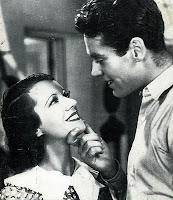 Later in the twentieth century the popular imagination was more likely to encounter the diva in movies rather than books. Several opera singers went from the stage to the screen. Grace Moore (1898-1947), a soprano who sang at the Met for sixteen seasons, appeared as Jenny Lind in two films for MGM (A Lady's Morals (1930) and Jenny Lind (1931)), but became an international star as an aspiring opera singer in One Night of Love (MGM, 1934). Lily Pons (1898-1976) capitalised on her position as the Met’s resident coloratura soprano by making three movies for RKO. The first of these, I Dream Too Much (1935) featured Pons as an aspiring opera singer, alongside Henry Fonda and a seal. The Polish soprano Miliza Korjus (1909-1980) (‘gorgeous Korjus’[1]) appeared as an opera singer and love interest of Johann Strauss II in MGM’s The Great Waltz (1938).
Later in the twentieth century the popular imagination was more likely to encounter the diva in movies rather than books. Several opera singers went from the stage to the screen. Grace Moore (1898-1947), a soprano who sang at the Met for sixteen seasons, appeared as Jenny Lind in two films for MGM (A Lady's Morals (1930) and Jenny Lind (1931)), but became an international star as an aspiring opera singer in One Night of Love (MGM, 1934). Lily Pons (1898-1976) capitalised on her position as the Met’s resident coloratura soprano by making three movies for RKO. The first of these, I Dream Too Much (1935) featured Pons as an aspiring opera singer, alongside Henry Fonda and a seal. The Polish soprano Miliza Korjus (1909-1980) (‘gorgeous Korjus’[1]) appeared as an opera singer and love interest of Johann Strauss II in MGM’s The Great Waltz (1938).Singers from Broadway and operetta also became popular, generally performing the role of ‘the young blond ingénue with the voice of a nightingale and the sweetness of heart to match.’[2] Kitty Carlisle (1910-2007) played Rosa Castaldi in the Marx Brothers movie A Night At The Opera (MGM, 1935), a lyric soprano whose principle role is that of love interest for the tenor Allan Jones. Love and music, or rather aspirations to both, seemed to be the extent of Hollywood’s vision of the opera singer. This was reinforced by the type of music presented: most of the movies involved opera excerpts interspersed with popular songs (written incidentally by giants such as Jerome Kern). This formula allowed singers with operatic potential but not experience to create careers out of the ingénue persona, with Deanna Durbin, Jeannette MacDonald and Kathryn Grayson the most prominent.
Opera, or Hollywood’s version of it, was good box-office – it was instant glamour and prestige. Paramount convinced the distinctly un-Hollywood Kirsten Flagstad (1895-1962) to don the winged helmet and metal breastplate to sing Brünnhilde’s Battle Cry in The Big Broadcast of 1938 (Paramount, 1938), with an introduction from no less than Bob Hope.
After WWII musical tastes had changed, and public affection for the singing ingénue began to decline. The audience was more likely to encounter negative stereotypes of the female opera singer, such as the conniving femme fatale Cecil Carver played by Linda Darnell in Everybody Does It (Twentieth Century-Fox, 1949). Occasionally the genuine article was encountered, but in melodramatic form. The film of Marjorie Lawrence’s memoir Interrupted Melody (MGM, 1954) told the breathtakingly romantic story of how she rose to fame, how she was tragically struck down by polio at the height of her career, and how with the miracles of modern medicine and the devotion of her husband she made a triumphal return to the operatic stage. It was a movie for its time: around the time of its release the world’s attention began to focus on one particular diva – Maria Callas. The public associated the diva with tragedy and temperament, a stereotype that has been as influential as the singing fat lady without whom nothing is over.
[1] Hedda Hopper, ‘Hedda Hopper’s Hollywood’, Los Angeles Times, 2 June 1938, p. 13; Nelson B. Bell, ‘“The Great Waltz” Tops All Film Operettas’, Washington Post, 23 November 1938, p. 10.
[2] Rupert Christiansen, Prima Donna: A History, (Harmondsworth: Penguin, 1986), p. 206.

No comments:
Post a Comment